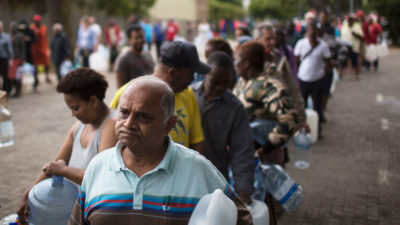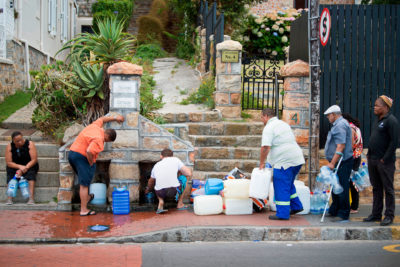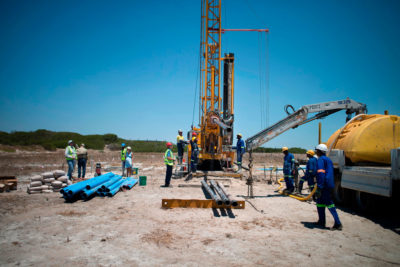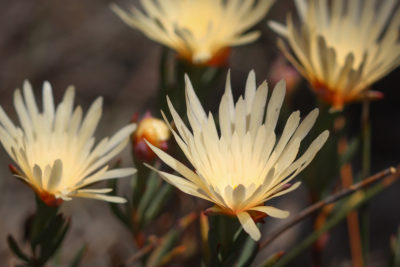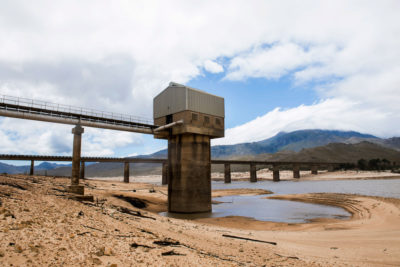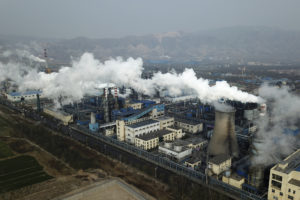在南非第二大都市的开普敦标志性桌山的支持下,引诱了越来越多的国际旅行者。它具有魅力的社区,明亮的海滩和令人叹为观止的自然景观,获得了丰富的旅游奖和发光的Instagram帖子的片段。
Recently, Cape Town also has become infamous as the home of “Day Zero,” the day when most of the city’s taps are predicted to run dry. With its major, rain-fed supply dams dangerously low after three years of drought, most of the city’s 4 million-plus residents — some rich, many desperately poor — have been facing the prospect of lining up at emergency water distribution points to collect a daily ration of just 6.6 gallons per person sometime before June or July. That’s when winter rains normally begin filling the reservoirs of this Southern Hemisphere city.
Now, largely thanks to radical conservation efforts — in January, the average Cape Town resident’s daily water quota was just one-third the amount used by the typical Californian at the height of that state’s 2016 drought — the city has reduced water consumptionby 57 percent。零日已经pushed back to July 9.And if the citizens of Cape Town (myself among them) continue to save as we have been, we should make it to the winter rainy season without having to line up for water.
那么,灾难避免了吗?再也看不见了吗?离得很远。纽约市在水方程的供应方面所做的努力远不如其在消费方面的工作。即使干旱在2018年结束了,而且很少有专家愿意预测 - 这场水危机的影响将多年(可能几十年)感受到。
How did Cape Town, one of the best-managed and wealthiest cities in Africa, find itself on the brink of running dry?
Cape Town’s predicament provides a global warning about the difficulty of ensuring water resilience in a warming world, even if, as with Cape Town, climate change is firmly on the agenda of city managers. Most climate models predict that the Cape Town region will become not only warmer, but drier, which bodes ill for a metropolitan area whose population has roughly doubled to 4 million in the past three decades and continues to grow at 1 to 2 percent annually.
And Cape Town’s rushed efforts to boost water supply by tapping into aquifers, including some in national parks and provincial nature reserves, are damaging valuable ecosystems and putting rare species at risk of extinction. The agricultural sector, including the Cape region’s world-renowned wine industry, has been forced to sharply cut back on irrigation, which is reducing production and leaving tens of thousands of people out of work.
So how did Cape Town, one of the best-managed and wealthiest cities in Africa, find itself on the brink of running dry? The city has, after all, won awards for its work on climate change. South Africa has some of the world’s most detailed, progressive water laws and deep expertise in water science and management, climate science, and meteorology. The city hasmapped projected sea level rise并召集了无数的气候变化改编计划会议。开普敦市长去年说:“如果没有考虑气候变化的影响,我们无法计划任何事情。”
A simple (and perhaps simplistic) answer to the cause of the current crisis is that rainfall was well below average for three years in a row, that no one could have or did predict that, and thus serious action to reduce water consumption — which should have begun in 2016 — came too late. The crisis has exposed significant weaknesses in scientists’ ability to forecast weather on a seasonal scale, which is when it matters to city managers and farmers, and predict rainfall on an annual or decadal scale, which is when it matters to developers of large-scale infrastructure, such as raising dam heights and building desalination plants.
南非的西南部地区有一种地中海气候,就像加利福尼亚中部海岸一样,夏季炎热,凉爽,多雨的冬季(6月至8月。)冬季降雨充斥着城市周围的六个大水坝,构成了构成的核心the Western Cape Water Supply System (WCWSS), which services the vast majority of the city’s residential and industrial water users, as well as farming areas and smaller towns nearby.
The winter rains are generally very reliable. Using historical rainfall data, Piotr Wolski of the气候分析组at the University of Cape Townhas determinedthat a multi-year drought as severe as the current one would only be expected once every few hundred years, perhaps less than once in a millennium. The ongoing drought in the catchments of the WCWSS dams, he writes, “is indeed very, very rare, and thusvery, very severe.”历史降雨记录表明,连续两年(2015年和2016年)已经有两个较差的降雨年龄,因此第三次糟糕的一年的机会(尤其是2017年一样糟糕)非常遥远。
In addition to historical data pointing to the extremely low likelihood of 2017’s winter being dry, the South African Weather Service modeled a three-month seasonal forecast for the winter of 2017 thatpredicted higher than average rainfall.Notwithstanding that seasonal rainfall forecasts for the Cape region are notoriously unreliable, it appears that officials were left feeling less urgency to impose hugely unpopular water restrictions or push forward with expensive water infrastructure projects early in the year.
Experts have long warned that Cape Town would find itself in a water crisis caused by converging drought, population growth, and the failure to secure new water resources. But because of uncertainties in water consumption rates and in weather and climate prediction, it’s been hard to fix a date.
The city’s water consumption has fallen from 317 million gallons per day in early 2015 to about 137 million gallons per day.
“Water security has always been seen as ‘important’ in Cape Town, but until recently it has not been seen as ‘urgent,’” says Christine Colvin, head of freshwater programs with WWF-South Africa. “We have an HIV/AIDS epidemic, an education crisis, massive unemployment — these are understandably ‘urgent’ to politicians” and have competed successfully for attention and funding. Add to this South Africa’s fractured government institutions, corruption, and the fact that the national government is responsible for bulk water infrastructure like dams, but municipalities are responsible for water distribution and demand management, and you have a recipe for inaction on major water projects.
Colvin说,此外,开普敦市为居民带来了可观的收入,因此它从未严重激励个人来保护。
但是,随着去年不断增长的水资源短缺的幅度,开普敦官员以积极的保护运动做出了回应。去年六月,所有人都在家里外面使用市政水was banned,意味着没有汽车洗车或花园灌溉。9月,所有用途(包括洗涤,饮酒和洗手间)的居民每天每天每天23加仑),今年2月初,每日个人配额减少到a mere 13 gallons.整个城市的水压降低了,从而减慢了居民水龙头的流量。市政当局已在高使用家庭上安装了数万个限制性设备,并大大增加了punitive water tariffsfor heavy users.
由于这些措施和其他措施,该市的用水量从2015年初的每天3.17亿加仑减少到大约137 million gallons per day.从4月12日到7月9日,零日被推迟。
Cape Town is now scrambling to augment its rain-fed dams with other sources, mindful that a further year of drought is not impossible. Government has identified various options, including desalinating seawater, reclaiming wastewater (i.e. purifying sewage, as is successfully done in some other cities), and tapping underground aquifers. But desalination plants are expensive to build and operate, wastewater treatment plants are time-consuming to construct, and so the city has prioritized the hasty drilling of dozens of boreholes. Many of the drilling sites are in protected areas that are government-owned, which simplifies access.
With its rain-fed dams running low, Cape Town has begun drilling boreholes to access the region's groundwater reserves, such as in the Mitchells Plain township, 15 miles from the city center.Rodger Bosch/AFP/Getty图像
钻孔和构建管道,尤其是在保护区,通常需要环境影响评估和详细的环境管理计划。然而,由于干旱紧急,省政府对生物学家和保护主义者的越来越关注,使这些要求大大放松了这些要求。
Cape Town is situated in the heart of theCape Floristic Region,一个非凡生物学多样性的独特领域,其中包含9,500种植物,其中约有70%是地方性的。Cape Floristic地区的主要植被类型(通常称为Fynbos)包含许多来自古代谱系的值得注意的物种。开普敦大学的植物学家威廉·邦德(William Bond)说:“这些植物就像植物界的莫娜·利萨斯(Mona Lisas)一样。”
Many of these plants are also dependent on seeps — permanently wet areas where underground aquifers naturally spill out on to the surface. Some are so rare that they only occupy single, tiny sites. “Drilling a single borehole in the wrong place could cause the extinction of a species,” says Bond.
Lampranthus schlechteri, a rare, native plant species found in the Wemmershoek Vlei wetland, which was recently damaged by efforts to drill for groundwater.
It may already be too late for the Wemmershoek Erica (Erica bakeri), a diminutive heath-like plant with tiny pale-pink, bell-shaped flowers. About two weeks ago, the rushed construction of a water borehole and a pipeline trench commissioned by the municipality of Stellenbosch severely damaged a wetland in a conservation area. The wetland is the last known habitat for the Wemmershoek Erica, and one of the last known habitats for other critically endangered plants. “Goodbye… How many thoughtless flushes were you worth?”tweetedCape Town ecologist Jasper Slingsby.
Notwithstanding the environmental impacts, there is enormous political pressure to proceed with borehole drilling. Biologists with the provincial nature conservation agency,CapeNature,have been forbidden to speak to the media. Nonetheless, documentation of environmental harm is leaking out:钻泥的溢出that fouled a long section of a pristine river; maps showing more than 200 planned borehole sites in ecologically sensitive areas; and consultants’ reports showing drilling foam and toxic pump-test water spilling into nature reserves.
“We shouldn’t go blundering into these natural areas, but now it’s like the drillers have a blank check to do that,” says Bond.
Slingsby担心,一旦钻孔钻孔,即使它们干燥了脆弱的湿地生态系统,在政治上也很难将其关闭。他说:“我不知道有任何放弃这样的水源的地方。”
Farmers in the region have had their water allowance cut 60 to 87 percent, and most irrigation has halted.
Almost all the Cape Town drought media coverage has focused on the city itself. Few reporters have paid attention to the rural areas around it, enormous acreages of which are covered in economically valuable vineyards, olive groves, and fruit orchards that require irrigation from the same six large dams and associated pipelines that sustain Cape Town. Farmers in the region have had their water allowance cut 60 to 87 percent, meaning that almost all irrigation was halted on February 1, even as many trees still carried fruit.
The Western Cape provincial government has estimated that50,000 agricultural jobswill be lost this year, mostly among seasonal fruit-pickers, leading to about 260,000 people requiring poverty-relief assistance. Most of South Africa’s wheat is grown near Cape Town, and many wheat farmers will not harvest a crop this season. Agri Western Cape, a farmers’ union, says that farmers around Cape Town have lostabout $1.2 billiondue to the drought. Twenty-two percent of the sheep in the region have been culled because of a lack of fodder.
Francois Viljoen ofVinpro, an organization representing vine-growers and winemakers, estimates an overall harvest reduction of 15 to 25 percent this year. Even if good rains fall in winter, “we will see a carryover effect next growing season, with reduced yields, because the vines have not been able to build up reserves during the drought.” Because of smaller harvests, seasonal fruit-pickers will again have reduced income, with significant effects on poor rural communities.
No one can say how long Cape Town’s water crisis will last. Even if good rains fall this winter, tight use restrictions will likely remain in place indefinitely; the dams have been drawn down so far that it may take years to refill them, and water augmentation projects may take years to scale up.
The Theewaterskloof dam, Cape Town's main water supply with a capacity of nearly 17 billion cubic feet, photographed on January 23, 2018. In late February, its reservoir's levelfell to 11 percent。AP照片
Longer-term, a changing climate may well add to Cape Town’s water pressures.
“The models agree that Cape Town will become hotter over the next century,” says Peter Johnston of the University of Cape Town’s气候分析组。“Most of the models — but not all — predict that it will become drier, too.” Increasing the city’s water resilience will mean expanding supplies from sources like desalination plants that are not as influenced by the vagaries of rainfall as the current dams. But these are expensive and energy-intensive, and residents will pay more, perhaps significantly more, for water.
The government will have to roll out new infrastructure amid considerable uncertainty about rainfall in the coming years, running the risk of over- or under-spending. Willem Landman of the University of Pretoria says that meteorologists “can make a reliable weather forecast that works for five days” and climate scientists “can model the average climate conditions a hundred years from now with a great degree of confidence. But decadal predictions? Forget about it. We don’t know how to set the models up. We can’t say what the rainfall is going to be 10 years from now.”
开普敦是否已经进入新的,气候变化,正常,更频繁的干旱的问题并不容易回答。克里斯汀·科尔文(Christine Colvin)说:“我们没有确定的信封。”“开普敦并不特别。在未来几年中,许多其他城市将面临这些挑战。”
